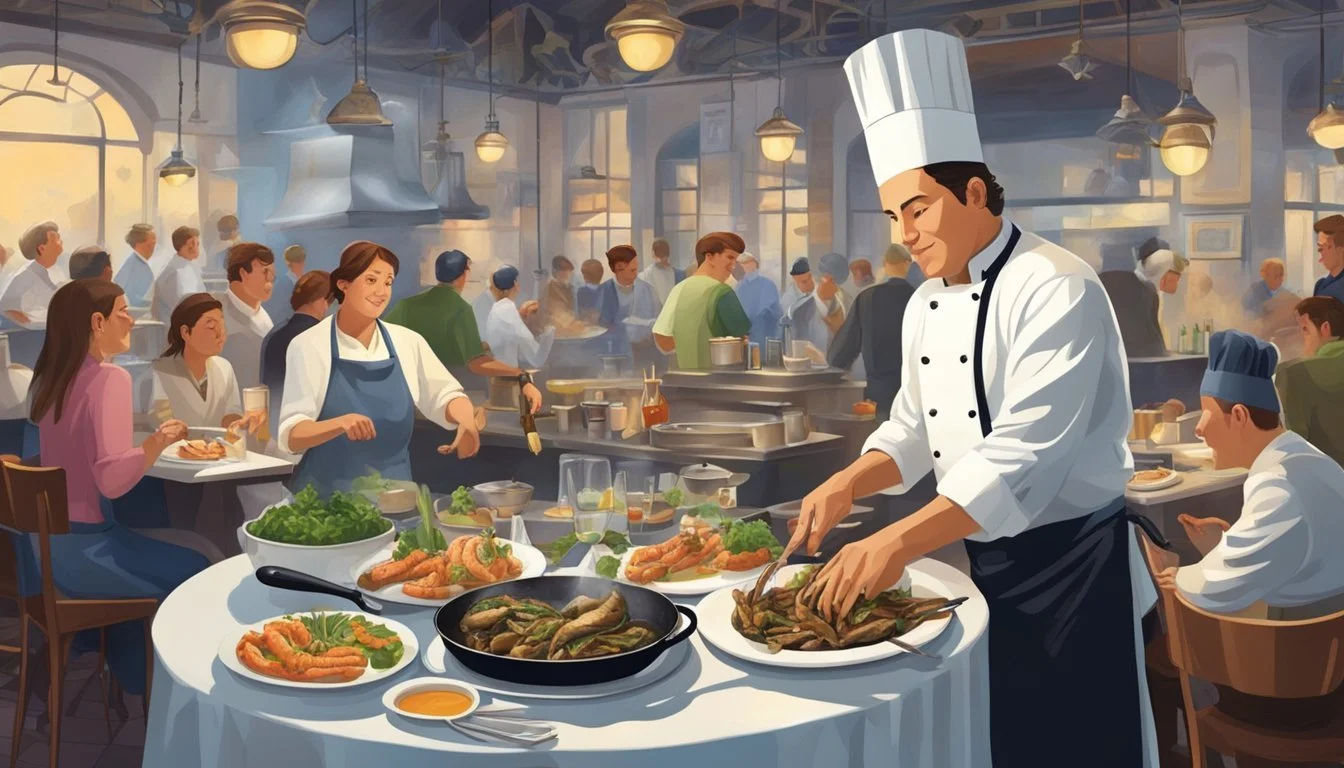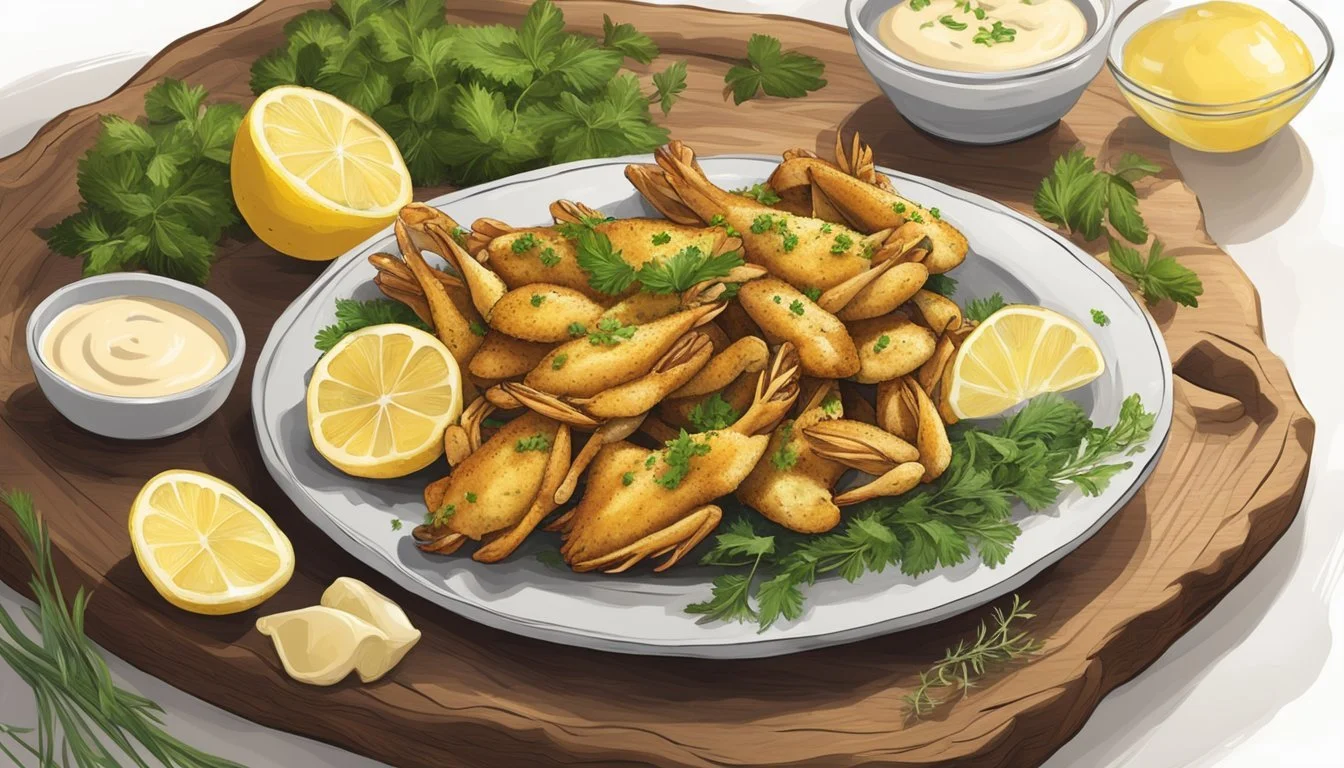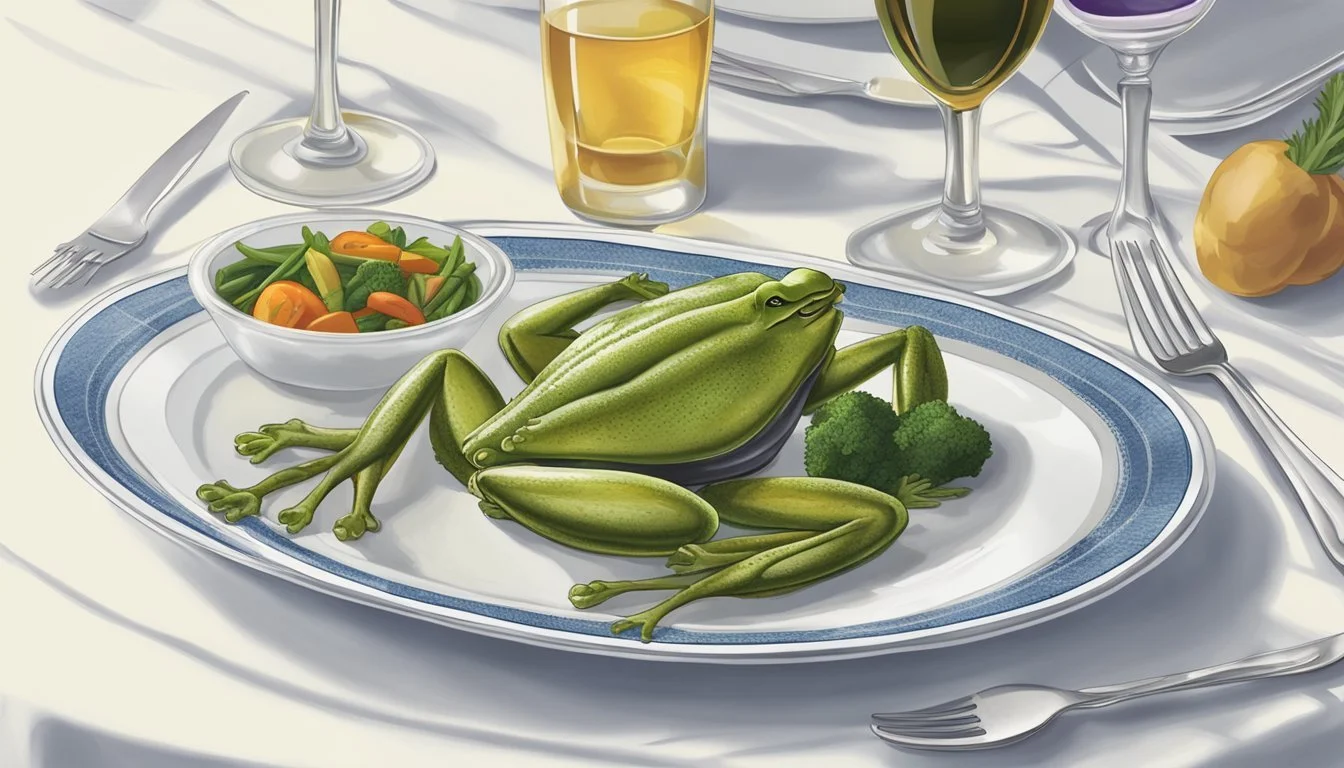Frog Legs
The French Delicacy Expanding Its Global Culinary Reach
Frog legs, traditionally known as cuisses de grenouilles in French, have long been a staple in French cuisine and are increasingly finding their way onto global menus. This unique delicacy, once born out of necessity during food shortages, has a history that spans over a thousand years. Renowned for their distinct texture and flavor, frog legs are enjoyed by diners seeking a taste of traditional French gastronomy and those intrigued by unusual culinary choices. They are usually prepared by marinating, then breaded and sautéd in butter with garlic and parsley, showcasing the simplicity yet sophistication of French cooking methods.
As the dish gains international interest, restaurants worldwide are beginning to incorporate frog legs into their offering, signifying the cross-cultural appeal of French cuisine. Despite their popularity, the sourcing and consumption of frog legs have raised environmental concerns, notably their impact on frog populations and ecosystem balance. This has led to calls for more regulated trade and sustainable practices to ensure that this delicacy can be enjoyed without compromising the species' survival.
The burgeoning interest in frog legs as a gourmet item exemplifies the broader trend of global cuisine borrowing from diverse food traditions. Gastronomes and curious diners alike are keen to explore these flavors, but with the rise in popularity, it is paramount that such practices are balanced with ecological responsibility. The continued enjoyment of frog legs, as with any wildlife-based dish, depends on the adherence to ethical sourcing and conservation efforts to ensure that this aspect of culinary heritage persists without detriment to the environment.
Historical Context of Frog Legs as Delicacy
Frog legs, considered a sophisticated component of French cuisine, have leapt onto dining tables around the world. Their global spread is a testament to their culinary appeal and adaptability across various cultures.
Frog Legs in French Cuisine
In France, frog legs have a well-documented history as a sought-after delicacy. Records from the 1600s indicate their prominence in Parisian restaurants, and they have long been associated with traditional French cuisine. Frog hunting has been a part of this gastronomic tradition, with specific seasons and methods dedicated to it. Despite their stronghold in French culture, where they could be likened to a national dish, frog legs are not universally consumed within the country.
Global Popularity and Spread
The international journey of frog legs started centuries ago, with evidence of consumption in southern China as early as the first century AD. They were also part of the diet among the Aztecs. Much later, frog legs began to appear on American menus, showcasing their versatility in various culinary settings. The global popularity of frog legs reflects the innate human curiosity to explore and integrate different tastes and food experiences from diverse cultures.
Culinary Techniques and Preparation
Preparing frog legs involves a blend of traditional French techniques and adaptations that suit global palates. One consistently applied method is soaking frog legs in milk to tenderize and remove any gamey flavor, followed by light seasoning and cooking to preserve their delicate texture.
Basic Frog Legs Recipe
The foundation of a classic frog legs dish starts with a simple soak in milk, a step that imparts tenderness to the meat. Prior to cooking, they are typically removed from the milk, patted dry, and then seasoned with kosher salt and black pepper. A light dusting of flour helps to create a crisp exterior when cooked.
Common Cooking Methods
Frog legs can be prepared using various techniques, each yielding a distinct texture and flavor profile:
Fried: Coated with a seasoned flour breading, frog legs are fried in vegetable or canola oil until they achieve a golden-brown crispness.
Sautéed: Cooking frog legs in a skillet with clarified butter or olive oil allows them to brown nicely while absorbing aromatics like garlic and fresh parsley.
Grilled: Lightly oiled frog legs are grilled for a smoky flavor, seasoned with spices such as paprika and cayenne pepper.
Stewed: Simmered in a mixture of liquids like white wine, beer, or broth to infuse depth and richness.
Advanced Culinary Preparations
In more sophisticated recipes, frog legs might be paired with complex sauces or marinades:
Fresh Parsley and Garlic Sauce: A classic French-style preparation includes sautéed frog legs served with a sauce of garlic, fresh parsley, and lemon juice.
Hot Sauce and Lemon Glaze: Those preferring a zestier kick might enjoy frog legs with a blend of hot sauce, lemon juice, and spices, reducing it to a glaze.
Each ingredient such as butter for richness, white wine for acidity, or lemon juice for a citrus note is selected to complement the frog legs' delicate flavor without overpowering it.
Food Pairings and Serving Suggestions
When it comes to enjoying frog legs, the right accompaniments can amplify both their delicate flavor and texture. Pairing them with suitable side dishes and sauces can elevate the dish into a memorable culinary experience.
Ideal Side Dishes
Frog legs pair well with a variety of side dishes that complement their subtle taste. Here are some suggestions:
Vegetables: Roasted or steamed green beans with a touch of butter and a sprinkle of fresh parsley.
Starches: Truffle risotto or no-fail French bread provide a hearty counterbalance to the lightness of frog legs.
Salads: A crisp Italian green salad or kale pasta salad with sun-dried tomatoes adds a fresh element to the meal.
Sauces and Accompaniments
The right sauce can refine the flavor of frog legs. Here are curated choices to enhance the dish:
Citrus Butter Sauce: A blend of melted butter, lemon juice, and chopped parsley highlights the frog legs' savory notes.
Garlic Sauce: Garlic, when sautéed with butter or olive oil, creates a rich sauce that complements the meat's natural flavors.
Wine Pairing: A glass of crisp white wine with citrus overtones matches well with the dish’s profile.
By choosing the appropriate sides and sauces, one can create a balanced and fulfilling dish with frog legs at the heart of the dining experience.
Nutritional Information and Dietary Considerations
Frog legs are acclaimed for their high nutritional value and are often grouped with other protein-rich, low-fat foods. A common comparison is made with white meat (What wine goes well with white meat?) chicken due to their similar nutrient profiles and culinary flexibility. Typically, a 100-gram serving of frog legs contains about 73 calories, making them a lean choice for those conscious of their calorie intake.
In terms of protein content, frog legs are robust, providing a substantial amount that can rival that of fish and seafood. Protein is essential for muscle repair and growth, and frog legs serve as a beneficial option for those looking to maintain or increase their protein consumption in a healthy manner.
Nutrient: Calories
Amount per 100g: 73
Nutrient: Protein
Amount per 100g: High
Nutrient: Fat
Amount per 100g: Low
Nutrient: Essential Nutrients
Amount per 100g: Present
The texture of frog legs is often likened to chicken, and they are recognized as a gastronomic delight. While frog legs offer a distinctive culinary experience, they also possess a variety of essential nutrients that contribute to a well-rounded diet.
Individuals looking for a sustainable and healthy protein source may find frog legs to be a suitable alternative. They contain a balance of beneficial nutrients without the high fat content typical of more conventional meats. As with any food, it is vital to source frog legs responsibly to ensure sustainability and ethical practices in their procurement.
Sourcing and Selection of Frog Legs
The sourcing of frog legs often requires balancing demand with sustainable practices, while selection prioritizes freshness and quality. Consumers and chefs alike place emphasis on the origins and handling of this delicate item before it reaches their plates.
From Hunting to Butcher Shops
Historically, frog legs were sourced directly from the wild, with local ponds being common hunting grounds. Today, they are more commonly found in butcher shops and specialty markets, vastly supplied by farms. This shift to organized farming aids in regulating species depletion and ensures a steady supply for consumption. These frogs, typically bullfrogs, are raised specifically for their hind legs, which are the coveted part for cooking.
Choosing Fresh over Frozen
When selecting frog legs, the choice between fresh and frozen varieties is crucial. Fresh frog legs should appear glossy and supple and are often seen in butcher shops and Asian markets, signaling recent preparation and minimal processing. In contrast, frozen frog legs should be free from freezer burn and stored at a consistent freezing temperature to preserve their quality. Whether one opts for fresh or frozen, storing them in a refrigerator under proper temperatures until use is vital for maintaining their delicate flavor, a cornerstone of fresh ingredients in French cuisine.
Cultural Significance and Food Identity
The culinary heritage of France has granted frog legs a prestigious status in gastronomy, while various other cultures have adopted this delicacy, integrating it within their own culinary traditions.
Frog Legs as a Symbol of French Gastry
In French cuisine, frog legs (Cuisses de Grenouille) symbolize a blend of tradition and gourmet excellence. Once considered a luxurious item, frog legs have their roots deep in the nation's history, often associated with French identity itself. They have been a part of French haute cuisine for centuries, savored by both royalty and common folk. Today, they signify the unique and inventive spirit of French culinary arts, contributing to its global reputation for fine dining and sophisticated flavors.
Adoption in Different Cultures
While indigenous to French menus, frog legs have hopped their way into various other culinary scenes. In the Southern U.S., particularly in Louisiana, this delicacy is embraced due to French cultural influence and has become a cornerstone of Cajun cuisine. Europe sees varied consumption of frog legs, but they are particularly popular in French-bordering nations. Beyond the West, they have found a place in parts of Asia, where frog legs are valued similarly for their distinct taste and texture, signifying how one nation's traditional food can leap into the global arena and blend into the fabric of different cultures around the world.
Ethical and Environmental Considerations
When dissecting the consumption of frog legs, ethical and environmental implications surface. The practice of hunting these amphibians has consequences on local pond ecosystems. Some species are harvested at a rate that outpaces their ability to reproduce, while others are taken from their natural habitats, disrupting ecological balance.
Environmental experts point out that sustainable methods are essential to prevent the decimation of frog populations. Over-harvesting can lead to a decline in species that are crucial for pest control and serve as indicators of environmental health.
Environmental Impact:
Declining frog populations in natural ponds
Disruption of the food chain
Potential decrease in natural pest control
Sustainable Practices:
Regulation of hunting practices
Farm-raising frogs to alleviate pressure on wild populations
Monitoring and enforcement of sustainable harvest limits
Concerns about inhumane treatment during the capture and handling process also raise ethical questions. Advocates stress the importance of adhering to humane standards to prevent unnecessary suffering.
By addressing these considerations, the industry can work towards ensuring that the delicacy of frog legs can continue to be appreciated without sacrificing environmental integrity or ethical responsibility.
Regulatory and Legal Landscape
The trade and consumption of frog legs, a culinary tradition in France, are subject to various regulations and laws. Governments and organizations are increasingly scrutinizing the impact on species and the environment, leading to legislation aimed at conservation and sustainability.
Trade: Imports of frog legs into the European Union are significant, with over 4,000 tons annually. This demand has implications for the species sourced, mostly from Indonesia and other Southeast Asian countries. The European Union (EU) has enacted strict customs and import regulations to monitor and control this trade.
Regulations: Environmental concerns have led to calls for stricter regulation. Some scientists and conservationists urge for more robust policies to ensure the protection of frog species at risk of decline due to over-harvesting. A group of over 500 environmental campaigners has advocated for more regulated trade in frog legs, addressing their concerns to French President Emmanuel Macron.
Laws: National law within France and EU-wide legislation contribute to the legal framework that governs the trade of frog legs. The EU's Wildlife Trade Regulations control the import, export, and use of wildlife products, which involves permits and certificates ensuring compliance with the Convention on International Trade in Endangered Species of Wild Fauna and Flora (CITES).
Import: The EU remains the largest importer of frog legs, necessitating a legal structure that reconciles culinary practices with ecological responsibility. Efforts to regulate imports focus on sustainability and enforcing legal trade to prevent depletion of frog populations.
Summary: The global appetite for frog legs has necessitated a complex regulatory and legal landscape, balancing cultural culinary practice with environmental stewardship. Through international conventions, EU regulations, and national laws, stakeholders strive to maintain a sustainable trade.
Presentation and Gastronomy
In the realm of French cuisine, frog legs have secured a place in the tapestry of culinary art thanks to their unique texture and flavor. Highly regarded by gourmets, the preparation and presentation of cuisses de grenouille demand a blend of tradition and finesse.
When presented on a plate, frog legs are often accompanied by fresh herbs and simple, complementary garnishes. Chefs may choose to lightly batter and sauté the legs, allowing the subtle taste to take center stage, or to offer them grilled with a hint of garlic and parsley—embodying the quintessence of French gastronomy.
Garnishing plays an instrumental role in the presentation, elevating the dish visually and enhancing the overall sensory experience. Common garnishes include:
Lemon wedges: For a bright, acidic touch.
Herbs: Parsley and tarragon are traditional favorites.
Butter sauce: A delicate drizzle adds richness.
Cooking Method: Sautéed
Description: Lightly fried to a tender crispness.
Cooking Method: Grilled
Description: Charred subtly for a smoky flavor.
Cooking Method: Poached
Description: Cooked gently, preserving tenderness.
The focus in the presentation of frog legs is on showcasing the main ingredient without overwhelming it. Understated elegance is key, and the plating is often designed to reflect the high status of this delicacy within French culinary culture. As frog legs continue to gain global recognition, the methods of preparation and presentation evolve, but the heart of the dish remains tied to the storied traditions it originated from.
Home Cooking vs. Restaurant Dining
The journey of enjoying frog legs can take one down two distinct paths: creating the dish in the comfort of one's own kitchen or indulging in the culinary expertise of restaurant chefs. Both avenues provide unique experiences in taste and presentation.
Preparing Frog Legs at Home
When cooking frog legs at home, individuals have complete control over how they want to season and cook the protein. The process often involves marinating the frog legs for tenderness, then choosing between various cooking methods such as sauteing, grilling, or broiling. Acquiring fresh frog legs can be a stumbling block for the home cook, but once obtained, numerous recipes are available that cater to a range of skill levels. The essential steps include:
Cleaning: Frog legs must be thoroughly cleaned and patted dry.
Marinating: Soaking in a mixture of herbs and spices enhances flavor.
Cooking: Methods vary from frying to baking, with frying being a common favorite.
Frog Legs on Restaurant Menus
In contrast, restaurants offer frog legs that showcase the chef's specialized techniques and local culinary traditions. Each dining establishment curates its own gastronomic experience, with frog legs often featuring in French or fusion cuisine menus. Restaurants typically serve this delicacy as an appetizer, with portions meticulously prepared and presented. The typical restaurant experience might involve:
Signature Preparation: Recipes developed by chefs to highlight unique flavors.
Presentation: Frog legs served with garnishes and sides that complement the main dish.
Atmosphere: The ambiance of dining out adds to the overall enjoyment of the meal.
Customers might find variations such as Cuisses de Grenouilles à la Provençale or frog legs prepared with fine herbs and garlic, highlighting the chefs' expertise and commitment to offering a refined taste of this traditional dish.
Innovation and Future Trends
Frog legs represent a niche yet enduring element of culinary trends, particularly within French cuisine. As global tastes evolve, chefs and food innovators are reimagining this traditional dish to suit contemporary palates and environmental concerns.
In the pursuit of innovation, frog legs are being prepared with an array of cooking techniques beyond the classic sauté. They are incorporated into modern fusion dishes, blending traditional French flavors with global influences. Culinary experts predict that frog legs could increasingly appear in:
Tapas and small plates, encouraging sampling among cautious diners
Sustainable sourcing options, like using invasive species to lessen ecological impact
Plant-based and lab-grown alternatives considering ethical and environmental concerns
The future of frog legs in gastronomy is also closely tied to ecological mindfulness. Chefs are becoming advocates for sustainable use of frog species to prevent overconsumption. This ranges from farm-raised frogs to selecting species not at risk, reflecting a balance between tradition and conservation.
Moreover, anticipating emerging evolving tastes, restaurants may highlight the unique texture and versatility of frog legs to appeal to adventurous food enthusiasts. While respecting culinary traditions, these approaches integrate modern dietary trends and sensibilities, ensuring frog legs remain a relevant and responsible choice for the future.









